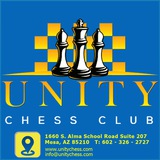Unity Chess Club
Alexander Kotov Gedeon Barcza Stockholm 1952 White to move
All the black pieces are extremely passive, and the Na7 creates a sad impression also. Not surprisingly, as well as possibilities of increasing the pressure gradually, White has an energetic decision:
22...Qe6 23.Bxg7 Nxg7 24.Qg5 Qe5 25.Nh6+ Kh8 26.Qxe5 dxe5 27.Rxd8 Rxd8 28.Nxf7++–.
This move had to be foreseen earlier – here, the bishop is invulnerable, also preventing moves by the black f-pawn, and a mating attack on the dark squares is inevitable.
The white pawn calmly advances to h6, as the black pieces need too much time to come to the aid of their king.
Unity Chess Club
Anatoly Karpov 2725 Wolfgang Unzicker 2510 Bad Kissingen 1980 White to move
White realises that Black can be checked and pinned along the 7th and 8th ranks, which prompts thoughts of the following idea:
If White plays prosaically and blockades the a-pawn with 32.Ra4, then after 32...Nf6 33.Nc5 e5!, the solidity of White’s central construction is broken, and he does not win the a5-pawn.
The point of White’s idea is revealed after 32...Rxa5 33.Qxa8+ Rxa8 34.Rxa8+ Kh7 35.Rb7 – the Nd7 is lost, as on 35...Qd6 there follows a pin from the other side — 36.Rd8.
33.Nb3 Rxa1 34.Nxa1 Ra2 35.Nc2 exd4 36.Qc8+ Kh7 37.Qc4 Ra8 38.Qd3+ Kg8 39.Nxd4
